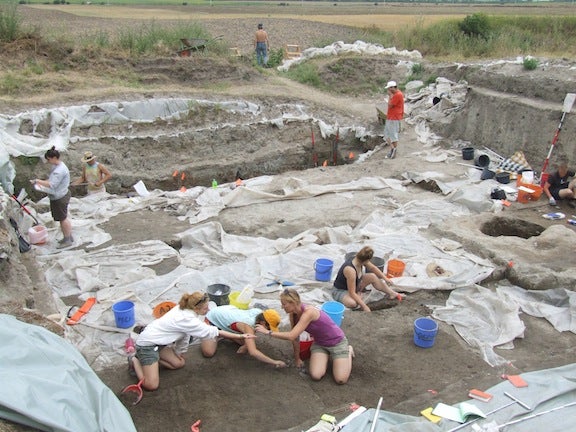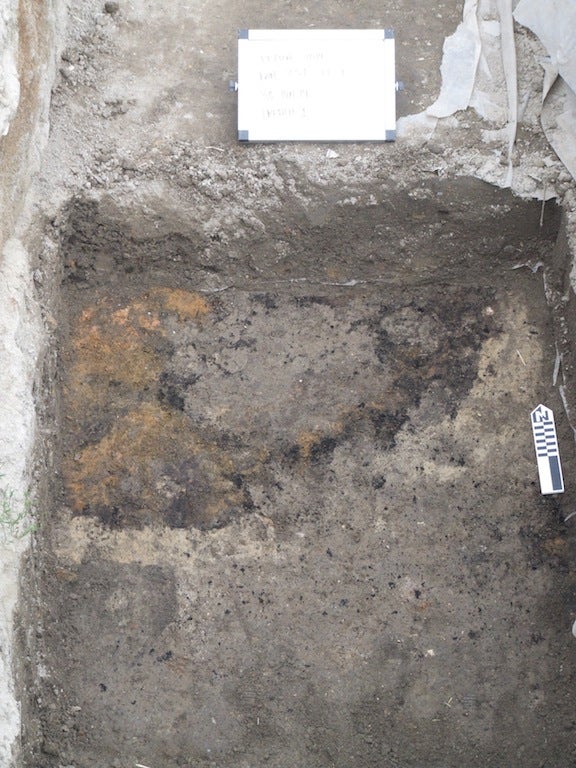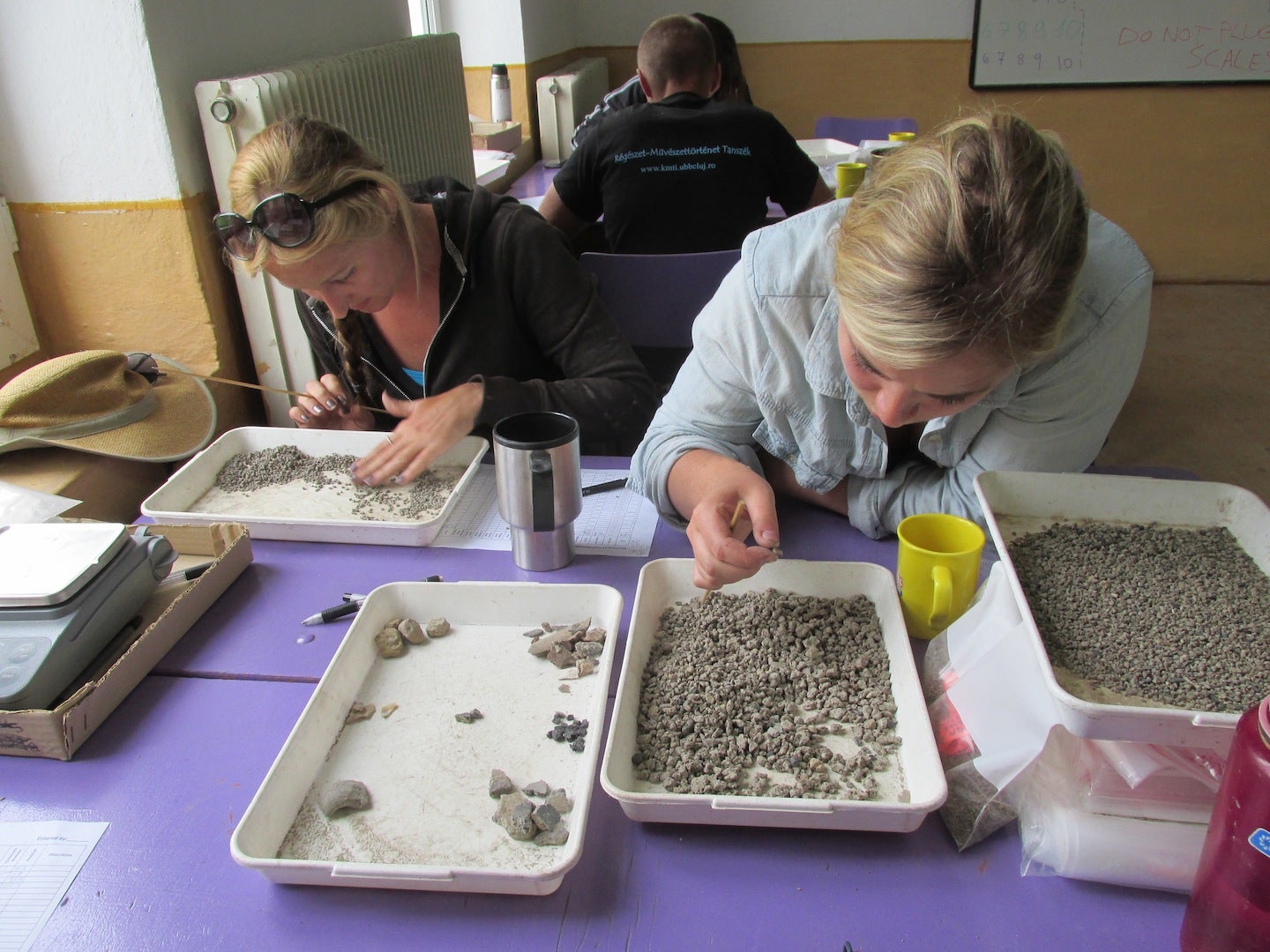 Greetings from Romania! We are well into our third week of fieldwork already. Most of the crew, which includes American, Hungarian, and Romanian archaeologists, arrived on June 21 and began working the next day. We have two goals for this year’s field season: (1) to deepen the stratigraphic trench to expose and date earlier deposits, and (2) to continue excavations on the main block.
Greetings from Romania! We are well into our third week of fieldwork already. Most of the crew, which includes American, Hungarian, and Romanian archaeologists, arrived on June 21 and began working the next day. We have two goals for this year’s field season: (1) to deepen the stratigraphic trench to expose and date earlier deposits, and (2) to continue excavations on the main block.
The site we are excavating, Pecica Şanţul Mare, is composed of a large, fortified tell and a peripheral village. The tell was occupied during the Early and Middle Bronze Age, the Iron Age, and the Middle Ages. It may have been occupied during other times as well, but the most intensive settlement occurred during these periods. The Middle Bronze Age at Pecica spans the period of 1500-1900 cal BC. We are not sure when the site was first occupied (sometime during the Copper Age or Early Bronze Age), but we hope to find out by the end of this field season!
Before commencing excavations, we removed the backfill dirt and tarps from last year, which kept our site safe through the winter. Before we could do any serious work, the weather took a turn for the worse. The site is at a high point in an agricultural field, reachable only by travelling on a dirt road. When it’s muddy, this road is impassable to our equipment truck and van. After the weather cleared, we were able to continue working.
Although it’s early in the field season, we’ve already made significant discoveries. Earlier this week, the crew exposed structure 11, which was excavated in part during the 2013 field season. During its last phase of occupation, structure 11 burned down. We found the remnants of architectural materials including posts and wattle, which were used to form the frame of the house. Underneath the burnt layer of the structure are additional, unburned floors, which we plan to excavate this field season. Further digging will reveal more about structure 11 and its inhabitants as well as the extent and nature of its occupation.
So far, excavations in the stratigraphic trench have revealed a possible new structure dating to either the Early or Middle Bronze Age.  Interestingly, we unearthed a piece of pottery dating to the Early Bronze Age or Early/Middle Bronze Age transition about a meter away from the house, suggesting that the structure might indeed date to an early period of the site’s occupation around 2000 cal BC. Like nearby structure 11, the new structure may have been burned after its final occupation. We found multiple burnt planks in the structure that we can use to determine a radiocarbon date for the stratum. We also found ceramics, animal bone, and a marine shell indicating contact or trade with coastal communities.
Interestingly, we unearthed a piece of pottery dating to the Early Bronze Age or Early/Middle Bronze Age transition about a meter away from the house, suggesting that the structure might indeed date to an early period of the site’s occupation around 2000 cal BC. Like nearby structure 11, the new structure may have been burned after its final occupation. We found multiple burnt planks in the structure that we can use to determine a radiocarbon date for the stratum. We also found ceramics, animal bone, and a marine shell indicating contact or trade with coastal communities.
On the other side of the tell, we are continuing excavations in the main block. The crew is currently working through layer E, a deposit underneath a burned platform. We will continue to work through layer E towards the same elevation as structure 11. This platform area of the site was a sort of central plaza surrounded by houses. It is rich in artifacts and vestiges of settlement. Some interesting finds include a model cart wheel, bronze fragments, and metalworking tools and byproducts like slag. There is also a range of chipped and groundstone artifacts and faunal remains.
Unfortunately, the weather has once again been unhelpful to us this past week. However, we’re taking this opportunity to catch up on lab work. In the lab, we sort artifacts by type (ie. bone, ceramic, metal, lithics) and then count and weigh them. We also process and sort floatation samples.  Floatation involves using water to separate small artifacts and cultural material we wouldn’t be able to find in a screen or by troweling from dirt. Sorting floatation samples takes a very long time, but can reveal important information about a site and its people. Botanical materials and small animal bones (ie. fish) can help us determine past diets and subsistence practices, and small bits of slag and stone can give clues about the craft activities practiced at Pecica. After all the floatation samples and other artifacts are sorted, they will be sent to specialists for further analysis.
Floatation involves using water to separate small artifacts and cultural material we wouldn’t be able to find in a screen or by troweling from dirt. Sorting floatation samples takes a very long time, but can reveal important information about a site and its people. Botanical materials and small animal bones (ie. fish) can help us determine past diets and subsistence practices, and small bits of slag and stone can give clues about the craft activities practiced at Pecica. After all the floatation samples and other artifacts are sorted, they will be sent to specialists for further analysis.
So far we’ve made promising progress inside the tell, but we have a long way to go. Hopefully the weather behaves more next week and we will be able to really dig into fieldwork! (Pun intended.)



